
Eucalypt is any woody plant with capsule fruiting bodies belonging to one of seven closely related genera found across Australia: Eucalyptus, Corymbia, Angophora, Stockwellia, Allosyncarpia, Eucalyptopsis and Arillastrum. In Australia, they are commonly known as gum trees.
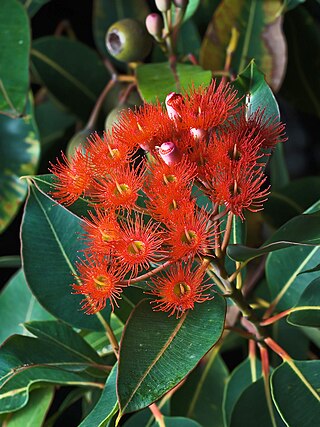
Corymbia, commonly known as bloodwoods, is a genus of about one hundred species of tree that, along with Eucalyptus, Angophora and several smaller groups, are referred to as eucalypts. Until 1990, corymbias were included in the genus Eucalyptus and there is still considerable disagreement among botanists as to whether separating them is valid. As of January 2020, Corymbia is an accepted name at the Australian Plant Census.
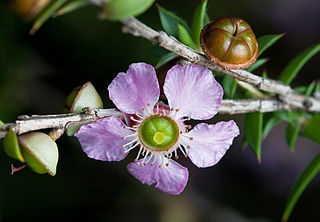
Leptospermum is a genus of shrubs and small trees in the myrtle family Myrtaceae commonly known as tea trees, although this name is sometimes also used for some species of Melaleuca. Most species are endemic to Australia, with the greatest diversity in the south of the continent, but some are native to other parts of the world, including New Zealand and Southeast Asia. Leptospermums all have five conspicuous petals and five groups of stamens which alternate with the petals. There is a single style in the centre of the flower and the fruit is a woody capsule.

Baeckea is a genus of flowering plants in the myrtle family, Myrtaceae, all but one endemic to Australia. Plants in the genus Baeckea are shrubs or small trees with leaves arranged in opposite pairs, white to deep pink flowers with five sepals and five petals, and five to fifteen stamens that are shorter than the petals.

Angophora costata, commonly known as Sydney red gum, rusty gum or smooth-barked apple, is a species of tree that is endemic to eastern Australia. Reaching 30 m (100 ft) in height, the species has distinctive smooth bark that is pinkish or orange-brown when new and fades to grey with age. Its lance-shaped leaves are arranged in opposite pairs along the stems, with white or creamy white flowers appearing from October to December. The flower buds are usually arranged in groups of three, followed by ribbed, oval or bell-shaped fruit.

Corymbia gummifera, commonly known as red bloodwood, is a species of tree, rarely a mallee, that is endemic to eastern Australia. It has rough, tessellated bark on the trunk and branches, lance-shaped adult leaves, flower buds in groups of seven, creamy white flowers and urn-shaped fruit.

Angophora hispida grows as a mallee, or as a tree to about 7 m (25 ft) in height. A. hispida's small size, especially when compared to its Angophora and Eucalyptus relatives, leads to it being known by the common name dwarf apple. It is native to a relatively small patch of central New South Wales – from just south of Sydney up to the Gosford area. The plant's leaves are sessile (stalk-less) and hug the stem with heart-shaped bases. Its previous name – A. cordifolia – referred to these cordate leaves. Another distinctive feature is the red bristly hairs that cover the branchlets, flower bases and new growth. This leads to the specific epithet hispida.

Angophora floribunda, commonly known as the rough-barked apple, is a common woodland and forest tree of the family Myrtaceae native to Eastern Australia. Reaching 30 m (100 ft) high, it is a large tree with fibrous bark and cream-white flowers that appear over the Austral summer. It grows on alluvial soils on floodplains and along watercourses. Much of the land it grew on has been cleared for agriculture.
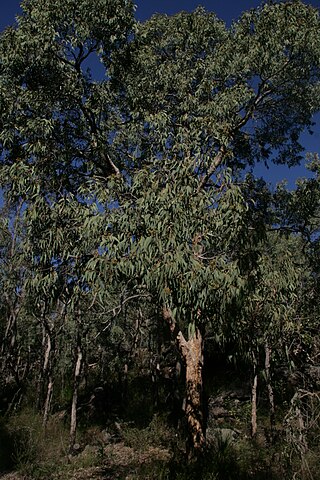
Corymbia eximia, commonly known as yellow bloodwood, is a bloodwood native to New South Wales. It occurs around the Sydney Basin often in high rainfall areas on shallow sandstone soils on plateaux or escarpments, in fire prone areas. Growing as a gnarled tree to 20 m (66 ft), it is recognisable by its distinctive yellow-brown tessellated bark. The greyish green leaves are thick and veiny, and lanceolate spear- or sickle-shaped. The cream flowerheads grow in panicles in groups of seven and appear in spring. Known for many years as Eucalyptus eximia, the yellow bloodwood was transferred into the new genus Corymbia in 1995 when it was erected by Ken Hill and Lawrie Johnson. It is still seen under the earlier name in some works.

Angophora bakeri, commonly known as the narrow-leaved apple, is a species of tree that is endemic to New South Wales. It has rough, fibrous bark on the trunk and branches, lance-shaped adult leaves, flower buds in groups of three or seven, white or creamy white flowers and oval to cylindrical fruit.
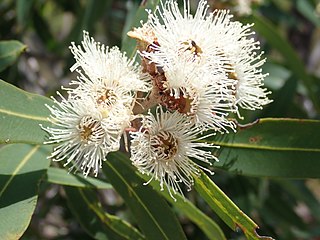
Angophora bakeri subsp. crassifolia is a small, shrubby tree or mallee that is endemic to a small area of New South Wales. It has rough bark on the trunk and branches, thick, rigid lance-shaped leaves, flower buds in groups of three or seven, white or creamy white flowers and cup-shaped to barrel-shaped fruit. It is similar to subspecies bakeri, differing in its smaller habit, thick leaves and slightly larger fruit.

Melaleuca nodosa, commonly known as the prickly-leaved paperbark, is a plant in the myrtle family Myrtaceae, and is endemic to eastern Australia. It is a shrub or small tree with narrow, sometimes needle-like leaves and profuse heads of yellow flowers as early as April or as late as January.

Angophora leiocarpa, commonly known as rusty gum, is a species of small to medium-sized tree that is endemic to eastern Australia. It has smooth bark on the trunk and branches, lance-shaped adult leaves, flower buds usually in groups of three, white or creamy white flowers and smooth barrel-shaped to cup-shaped fruit.

Corymbia watsoniana, commonly known as large-fruited yellowjacket, is a species of tree that is endemic to Queensland. It has rough, tessellated bark on the trunk and branches, egg-shaped to broadly lance-shaped adult leaves, flower buds in groups of seven, creamy white flowers and barrel-shaped or urn-shaped fruit.
Angophora costata subsp. euryphylla is a species of medium-sized to large tree that is endemic to a restricted area of New South Wales. It has smooth bark, lance-shaped adult leaves, flower buds in groups of three, white or creamy white flowers and cylindrical to barrel-shaped fruit. It is similar to subspecies costata but has broader leaves and larger fruit.
Angophora paludosa is a tree species that is native to eastern Australia.

Eucalypteae is a large tribe of flowering plants in the family Myrtaceae; members of this tribe are known as eucalypts. In Australia the genera Angophora, Corymbia, and Eucalyptus are commonly known as gum trees, for the sticky substance that exudes from the trunk of some species. As of 2020, the tribe comprised around 860 species, all native to Southeast Asia and Oceania, with a main diversity center in Australia.
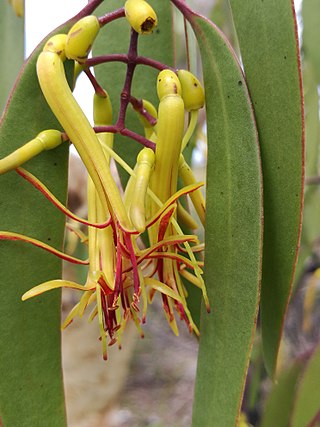
Muellerina eucalyptoides, commonly known as creeping mistletoe, is a hemiparasitic aerial shrub in the family Loranthaceae. The species is endemic to Australia.

Angophora bakeri subsp. bakeri, commonly known as narrow-leaved apple, is a small to medium-sized tree that is endemic to New South Wales. It has rough bark on the trunk and branches, flower buds in groups of three or seven, white or creamy white flowers and cup-shaped to barrel-shaped fruit.
Angophora costata subsp. costata is a species of medium-sized to large tree that is endemic to eastern Australia. It has smooth bark, lance-shaped adult leaves, flower buds in groups of three, white or creamy white flowers and cylindrical to barrel-shaped fruit. It is similar to subspecies costata but has narrower leaves and smaller fruit.




















